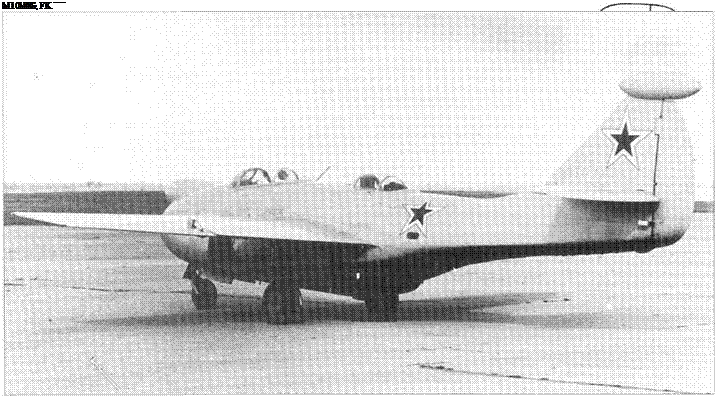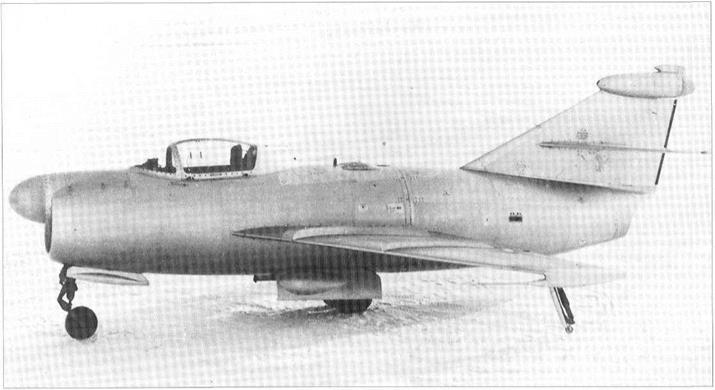MIG-9L, FK
 |
Purpose: To test the guidance system of a cruise missile.
Design Bureau: OKB-155 ofAI Mikoyan.
In late 1947 the Kremlin ordered the development of a large cruise missile which could be launched (primarily against ships) from the Tu-4. Because of the importance of this project it was assigned to a joint team formed by OKB No 155 (MiG) and a new semi-political group called SB-1 (Special Bureau Nol). The OKB assigned one of the founders, M I Gure
vich, as titular head, but the Chief Designer was A Ya Bereznyak who has figured previously on page 29 of this book. Head of SB-1 was S L Beria, son ofthe formidable Politburo member who in 1953 succeeded Stalin. In fact, SB-1 faded from the scene, as it had little to contribute, though it did have P N Kusenko as Chief Designer. Under intense pressure a swept-wing turbojet-engined missile was created, which later went into production as the KS-1 Komet. In early 1949 its guidance system was tested in an Li-2 (Soviet derivative of
the DC-3), and later in that year a more representative system was tested in the FK (also called MiG-9L, Laboratoriya). This was too large to be carried aloft by a Tu-4, so it formated with the Tu-4 parent aircraft and thence simulated the missile on its flight to the target. Subsequently this aircraft was used to test different cruise-missile guidance systems, assisted by the K-l, a manned version of the KS-1 missile.
Aircraft FK was a modified MiG-9 twin-jet fighter, the first type of turbojet aircraft to fly in
the Soviet Union. Features included a straight-tapered wing oflaminar profile of9% thickness with large slotted flaps and Frise ailerons, a pressurized cockpit ahead of the wing, a ground-adjustable tailplane mounted part-way up the fin, a nosewheel retracting forwards and main landing gears retracting outwards, and a nose inlet feeding air to two RD-20 turbojets (Soviet copies of the German BMW 003A, each rated at 800kg, l,7641b, thrust) mounted under the wing with jet nozzles under the trailing edge. The final production series had an ejection-seat, and the FK was from this batch. The heavy nose armament of three NS-23K guns and all armour
were removed, and the fuselage was extended by splicing in an extra section accommodating an unpressurized rear cockpit with a side-hinged canopy for the guidance-system operator. As in the Komet, the missile’s radar dish antenna was mounted above the nose, and a receiver antenna was mounted on the leading edge of each wing. Above the fin was a streamlined container housing the aft-facing transmitter and receiver antennas for the radio-command guidance from the parent aircraft after launch. Once the autopilot had set the correct course the nose radar homed on the parent’s radar signals reflected back from the target. Nearer the target the missile’s
own radar became active, steering by signals received by the leading-edge antennas.
So far as is known, the FK played a valuable role in the development of one of the world’s first turbojet cruise missiles. So did the KSK, a piloted version ofthe missile itself.
Dimensions (FK)
Span 10.0m 32ft9Kin
Length 10.12m 33 ft 2 in
Wing area 18.2m2 195.9ft2
No other data.
|
|
|












